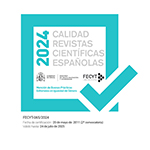Privanza, patronazgo y fiscalidad indiana en la corte de Madrid durante el reinado de Felipe IV
Resumo
Entre los años 1629 y 1632, el gobierno central de la Monarquía, controlado por el conde-duque de Olivares, se abocó a la elaboración de un voluminoso conjunto de medidas fiscales que tenían como destinatarios a los virreinatos americanos. A través del estudio de las diferentes alternativas de este caso, el presente artículo propone demostrar que, si bien las diversas instituciones implicadas en este proceso estuvieran compuestas por numerosos parientes, allegados y protegidos del valido, la toma de decisiones continuó nutriéndose de lealtades, criterios o intereses no siempre concurrentes con los del favorito real. Frente a sus demandas, el Consejo de Indias preservó unos apreciables márgenes de maniobra. En este caso puntual, la condición de los actores parece brindarles un sustento para obrar con una libertad que, probablemente, en otras circunstancias no hubieran podido poner en práctica a raíz de sus lazos con el valido y la desigualdad de su condición.Downloads
##submission.format##
Licença
La Revista Complutense de Historia de América, para fomentar el intercambio global del conocimiento, facilita el acceso sin restricciones a sus contenidos desde el momento de su publicación en la presente edición electrónica, y por eso es una revista de acceso abierto. Los originales publicados en esta revista son propiedad de la Universidad Complutense de Madrid y es obligatorio citar su procedencia en cualquier reproducción total o parcial. Todos los contenidos se distribuyen bajo una licencia de uso y distribución Creative Commons Reconocimiento 4.0 (CC BY 4.0). Esta circunstancia ha de hacerse constar expresamente de esta forma cuando sea necesario. Puede consultar la versión informativa y el texto legal de la licencia.











